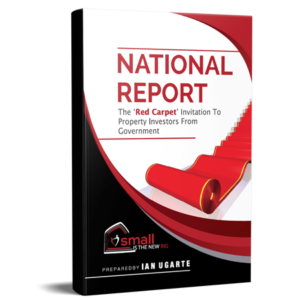Have regional property markets had their heyday? Are their still opportunities for investors in the post COVID-19 market? Check out my chat with Domian.com.au along with the nations top property experts as we dissect the current state of regional markets around the nation BELOW.
Regional property price growth triples capital city markets, new research find
By Alexandra Cain, Domain.com.au, July 20, 2020
Regional property markets have significantly outperformed city markets on average over the past year, with new research indicating median prices in regional areas across the country were up by an average of 3.4 per cent for the year to June 30, 2020.
By contrast, capital city markets grew by just 1 per cent in the same period, according to the research by PRD Real Estate, released Thursday.
Price growth was strongest in Melbourne, Sydney and Hobart, but price declines in Adelaide, Perth and Darwin weighed on the capital city average.
Regional median prices were higher or steady in all states, with regional Tasmania up by 9.8 per cent, regional NSW up by 5.3 per cent in and regional Victoria up by 4.4 per cent for the year to June 30.
Average growth in capital city median house prices, 2018-2020
| 1st half 2018 | 2nd half 2018 | 1st half 2019 | 2nd half 2019 | 1st half 2020 | |
| NSW | -9.7% | -7.7% | -8.6% | 5.7% | 10.8% |
| QLD | 1.5% | 1.5% | 0.7% | 0.7% | 3.6% |
| VIC | 6.3% | -15.2% | -17.6% | 8.4% | 14.3% |
| WA | -9.6% | 9.1% | 37.5% | -9.4% | -9.1% |
| TAS | 9.5% | 4.4% | 3.4% | 1.6% | 9.0% |
| NT | -8.3% | -3.8% | -3.5% | -5.8% | -6.0% |
| SA | -9.8% | 32.9% | 34.7% | -10.5% | -15.4% |
Note: ACT excluded. Source: PRD Research
One of the reasons regional markets are doing well is because they are more insulated from economic shocks, as they rely less on international trade and housing is more affordable.
As might be expected during a pandemic, PRD’s Time to Buy a Dwelling Index across Australia in June indicated buyers are sitting on the fence when it comes to making a purchase. Many markets are sitting around 100 points, with any number above 100 indicating positive sentiment.
Sentiment is most positive in Western Australia at 108.4 points, followed by Tasmania at 104.1 points, while the index is in negative territory at 97.8 points in NSW, 99.9 points in Victoria and 98.2 points in Queensland.
“Overall, these readings represent a 12.2 per cent decline in the 12 months to June, which is not surprising considering COVID-19 conditions. That said, the June quarter Time to Buy a Dwelling Index reading is similar to that of the June quarter of 2018, which suggests a relatively stable and balanced property market over the past 24 months,” says PRD Real Estate chief economist Diaswati Mardiasmo.
Average growth in regional median house prices, 2018-2020
| 1st half 2018 | 2nd half 2018 | 1st half 2019 | 2nd half 2019 | 1st half 2020 | |
| NSW | 2.5% | 0.5% | -2.8% | 3.8% | 5.3% |
| QLD | 0.5% | -1.1% | -1.2% | 2.8% | 0.0% |
| VIC | 5.5% | 6.6% | 3.3% | 4.4% | 4.4% |
| WA | -3.6% | -3.4% | 1.5% | -0.1% | -0.5% |
| TAS | 9.1% | 7.0% | 4.7% | 9.3% | 9.8% |
| NT | -4.3% | -4.5% | -4.5% | -11.7% | 2.5% |
| SA | -1.7% | 2.6% | 1.4% | 0.8% | 2.2% |
Note: ACT excluded. Source: PRD Research

Why regional markets outperformed
Commenting on the Victorian market, Mark Nunn, a director at Buxton Ballarat real estate, says property prices have held up and inquiries are growing for the Ballarat area.
“Melbourne buyers understand they get better value for money in Ballarat. Many are now seeking to shift out of the city to regional Victoria as more people are working from home full time. Metropolitan buyers also tell us they want to leave the Melbourne and buy in our region for better air quality and lifestyle reason,” Nunn says.
Ian Ugarte, co-founder of property developers Small Is The New Big, notes regional prices are increasing more rapidly because the metro markets have risen for the past 10 years and regional markets haven’t kept up.
“There’s value for money in regional markets. But buyers haven’t yet missed the boat. There’s opportunity for people to go into these markets and make the most of prices before they really rise,” Ugarte says.
Stimulus boosts new homes and lending
Data shows parts of the market are recovering after tough times earlier in the year. For instance, new home sales increased by 77.6 per cent in June 2020, from a record low result in May. “The HomeBuilder scheme is balancing the downturn in residential construction due to COVID-19,” says Mardiasmo.
The federal government unveiled the HomeBuilder grant in June to help stimulate the residential construction industry. Eligible applications can access $25,000 through the scheme to build a new home or substantially renovate an existing one.
Government stimulus initiatives are also propping up home loan demand. PRD’s figures show upgraders and first-home buyers are taking advantage of government grants and competitive offers from banks. Upgraders made up 42 per cent of loans in June, with first-home buyers making up 21 per cent of loans, the highest point this figure has reached since 2013.
According to PRD’s data, in May 2020 refinancing activity made up 36 per cent of loans lodged. Mardiasmo attributes this figure to borrowers taking the chance to examine their circumstances and make changes to their financial arrangements.
Mixed rental market
The research shows the rental market is holding up. Vacancy rates hit a peak of 2.6 per cent in April, but this still means 97.4 per cent of rental properties were occupied.
The rental market was a point of concern in the first half of 2020. But PRD’s analysis of the rental market since 2005 shows it tends to recover quickly after a shock, with the vacancy rate likely to decline within two to three months of a shock.
Not all rental markets performed equally. Vacancy rates in Sydney were above market average due to dropping demand as overseas visa holders and international students leave the market. SQM Research data shows a 16.2 per cent rise in vacancy rates in the Sydney CBD, with Melbourne CBD vacancy rates at 5.4 per cent.

Outlook
The dive in consumer confidence over the past month could play out in the property market in coming weeks, however. The Melbourne Institute and Westpac Bank Consumer Sentiment Index dropped by 6.1 per cent to 87.9 points in July, after rising 6.3 per cent in June. July’s drop can be attributed to the COVID-19 outbreak in Victoria and renewed lockdown restrictions in Melbourne.
While NAB’s business confidence figures for June rose 17 points to minus seven points, this data was collected before the Victorian lockdown and may not represent current business sentiment.
Nevertheless, Mardiasmo remains bullish about the outlook for the property market, even if it is in survival mode.
“We do have a lot of balls to juggle, for example unemployment, household income, home-owners’ and landlords’ fears. But this is being balanced out by a multitude of stimulus packages, grants and new regulations.”
Home-owners’ and landlords’ concerns are also being offset by extremely low interest rates and lenders’ actions to allow borrowers to defer payments for a period. Many construction projects have also stalled, but this is also being offset by the HomeBuilder grant.
As for the outlook for the regional property market, Ugarte says working from home and companies decentralising operations will drive demand for some properties.
“People can now move one or two hours away from their work place and buy in regional areas, which will drive these markets up. A softening of the two major Melbourne and Sydney markets is likely, and a rise in demand for properties in Perth, Adelaide and Brisbane will continue.”





